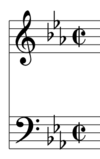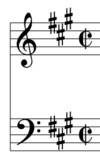Grade 4 Flashcards
(133 cards)
What is the name of this clef?

Alto clef
Also known as the C clef because its middle centres on middle C
What is the name of this clef?

Treble clef
Also known as the G clef because the curved line in the middle of the clef curls around the G note line
What is the name of this clef?

Bass clef
Also known as the F clef because its little dots go on either side of the line where the F note sits
What are open strings?
The notes that sound when you play a string instrument without putting your fingers down to change the pitch
What is the bass clef space notes acronym
All
Cows
Eat
Grass

What is the bass clef line notes acronym
Great
Big
Dogs
Fight
Animals

What clef does a violin play in?
Treble clef
What clef does a viola play in?
Alto clef or treble clef
What clef does a cello play in?
Bass clef
What clef does a double bass play in?
Bass clef
What clef does a classical guitar play in?
Treble clef
What clef does a flute play in?
Treble clef
What clef does a descant recorder play in?
Treble clef
What clef does an oboe play in?
Treble clef
What clef does a bassoon play in?
Bass clef
What clef does a french horn in F play in?
Treble clef
What does chord progression mean?
Means the order inwhich chords move from one to another in a piece of music
What does it mean when the harmonic rhythm is regular
The chord changes once a bar
What does it mean when the harmonic rhythm is static?
The chord stays the same for more than one bar (e.g. if it is for 3 bars its known as being static for three bars)
What does it mean when the harmonic rhythm is irregular?
The chord changes are not in the same pattern
Describe the harmonic rhythm in the following music

Harmonic rhythm is regular throughout
If a few notes are to be sung to one syllable a _____ must be added to show where the sound of the syllable should end)
- or _ ??
Underline
If a word has more than one syllable, a _____ must be added to link the syllables together
- or _ ??
Hyphen ( - )






































































